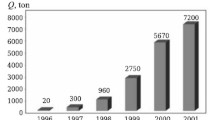Abstract
The state-of-the-art in the field of creation and use of spinel, spinel-forming, and corundum-spinel concretes in the world is analyzed. In contrast to foreign-made concretes of this calss produced using high-alumina cement Russian specialists have developed cementless spinel concretes of the type of ceramic castables. Achievements in the field of low-cement self-flowing (cast) concretes, which are often more effective than vibrocompacted ones, are considered. The factors that determine their quality are analyzed. Concretes of this class can be obtained on the base of ceramic binders (HCBS). Due to their diminished (compared to low-cement concretes) water demand the materials can possess a lower porosity.
Similar content being viewed by others
References
B. Nagai, O. Matumoto, and T. Isobe, “Development of high alumina castable for steel ladle (a few results on spinel formation in the alumina-magnesia castable),”Taikabutsu, Refractories, No. 5, 284–289 (1988).
M. Nishi, H. Kato, T. Anzai, et al., “Investigation on basic castable refractories for teeming ladle,”Taikabutsu, Refractories,37(1), 29–34 (1985).
O. Thelen, “Ungeformte Feuerfeste Baustoffe—von der Stampfmasse bis zum Hochleistungsprodukt,”Keram. Zeitschrift,44(8), 501–507 (1992).
É. Konisi, H. Nakazima, and S. Sudo, “Use of a self-flowing castable for lining the bottom of a steel-teeming ladle,”Dzaire to Purosesu,7(4), 911 (1994).
T. Kendall, “Steel industry monolithic,”Industrial. Minerals, No. 11, 33–45 (1995).
E. Ruh, “Worldwide trends in refractories,”Ceram. Industry,144(2), 31–38 (1995).
Yu. Otiai, K. Matsuo, and T. Osima, “Use of an alumina-spinel castable for the bottom in a steel-teeming ladle,”Taikabutsu,47(11), 558 (1994).
Materials of the Plibrico Firm (Europe) Reported at the Seminar “Refractories and Refractory Materials of Dinur JSC for the Metallurgical Industry,” [in Russian], July, Pervoural’sk (1997).
Author information
Authors and Affiliations
Additional information
Translated from Ogneupory i Tekhnicheskaya Keramika, No. 4, pp. 12‐18, April, 1998.
Parts I and II have been published in Nos. 2 and 3, 1998.
To be continued.
Rights and permissions
About this article
Cite this article
Pivinskii, Y.E. New refractory concretes and binding systems: Basic trends of development, production, and use of refractories in the 21st century. Part III. Spinel and cast (self-flowing) concretes. Refract Ind Ceram 39, 125–130 (1998). https://doi.org/10.1007/BF02768038
Received:
Issue Date:
DOI: https://doi.org/10.1007/BF02768038




